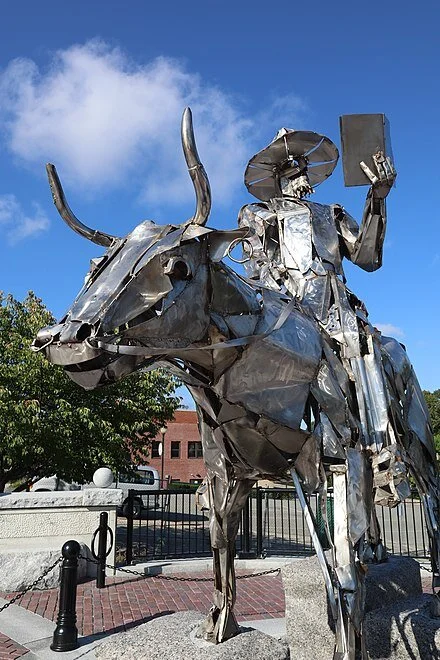
Leave him up
William Blackstone in glorious stainless steel in Pawtucket, R.I.
Adapted from Robert Whitcomb’s “Digital Diary,’’ in GoLocal24.com
The bookish William Blackstone (1595-1675) (also called Blaxton) was an Anglican minister who might have been the first permanent white resident of what is now Rhode Island, moving down from Boston and settling in today’s Lonsdale section of Cumberland in 1635, the year before Roger Williams founded Providence. The Blackstone River and a bunch of other things around here are named for him.
In the future Cumberland, on the east bank of the river that would bear his name, the reclusive and apparently kindly and tolerant intellectual read, wrote, tended cattle, planted gardens, and cultivated an apple orchard; he came up with the first variety of American apples, the Yellow Sweeting. He called his home "Study Hill," and it was said to have the largest library in the English colonies at the time. Sadly, his library and house were burned down in 1675 during King Philip's War, the very bloody and destructive conflict between Native Americans and English colonists that lasted from 1675 to 1678 and changed the course of American history. Blackstone died in 1675, just before the outbreak of the conflict.
Consider that his friends included the Narragansett tribe chiefs Miantonomi and Canonchet and the Wampanoags’ Massasoit and Metacomet. Metacomet is also known as King Philip (to mark the friendly relations his father, Massasoit, had with the English), whose followers were the ones who destroyed Blackstone’s home.
But now some Narragansetts want a new stainless-steel sculpture of Blackstone at the corner of Roosevelt and Exchange streets in Pawtucket taken down. They’re trying to make him into some sort of symbol of the brutal white takeover of their lands and the vast suffering and death of Native Americans that accompanied the English colonialization of what the English named New England. But Blackstone is a pretty inaccurate example of white aggression!
It’s appropriate that his statue remain up, given his importance to the history of the region. It’s not as if this is a statue of the likes of the cruel slaveowner, and traitor, Robert E. Lee. Such works are best kept in museums. (There are no statues of Hitler in outdoor parks in Germany, despite his historical importance.)
And, yes, you could say that George Washington was a traitor to Britain and he owned slaves. But unlike Lee, he didn’t take up arms against “his country” to ally himself with a “country’’ whose central mission in its rebellion against the United States was the preservation and indeed expansion of slavery. And Washington, whose slaves were freed at his death under his will, also was not considered a cruel slaveowner.
Anyway, why not see if a statue of a Native American chief from Blackstone’s time in Rhode Island could be commissioned to be put up near Blackstone’s? It would be culturally healthy if we had a wider range of historical figures represented by our public statues.
Here’s a nice crisp biography from the Rhode Island Heritage Hall of Fame:
http://www.riheritagehalloffame.org/inductees_detail.cfm?iid=45

